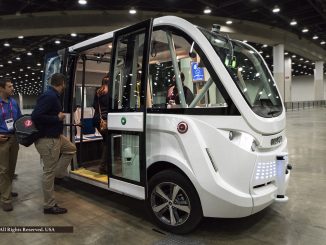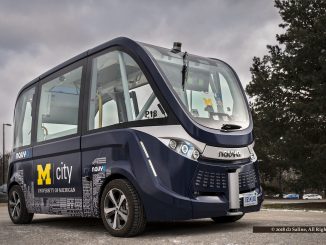
Last month, Wired magazine published its “Guide to Self-Driving Cars.” If that article doesn’t make this subject just that simple and straightforward, it must go a long way to reinforcing the idea that autonomous vehicles are mainstream and inevitable.
This is important subject matter for Saline. As a municipality, the bifurcation of downtown by US-12 makes us a likely prospect for this tech. As home to NAVYA and the greater Mcity infrastructure, Saline is part of the autonomous vehicle industry.
Last week, Saline Journal published its first article covering Autonomous Car Detroit held in Dearborn on March 14. Its street-level point of appeal was as promised relief to downtown parking problems. Now this follow-up feature explores the larger context upon which fulfillment of those promises must rely. [2]
In his keynote address that opened the conference, Uber Head of Vehicle Programs Stephen Lesh proffered three pre-requisites to what he called “the self-driving ecosystem” — after the autonomous vehicle itself. [3]
- Mature ridesharing network [4,5]
- Fleet operations infrastructure
- Accepted rider experience
As a precursor to ridesharing, ridehailing is already here. As it happens, the current Ann Arbor Observer lead with a feature on “what it’s like driving for Uber and Lyft.” But, as pointed out by May Mobility Co-Founder and CEO Edwin Olson, it has a serious current shortcoming of “circling vehicles” waiting for a typical thirty-two to fifty percent occupancy rate. [6,7]
Moving to the next, recommended, step of ridesharing will require a societal paradigm shift in terms of expectations for personal vehicle ownership. Gary Silberg of KPMG cited a current statistic of 2.6 cars per family. He predicted that ridesharing will mean 1.6 within two or three years, and 1.0 cars per family in 2030. [8]
Beyond this, Uber already appears to be quite advanced in terms of aggregating data needed to make vehicle deployment decisions. Think several orders of magnitude beyond what Huron Valley Ambulance uses to determine current number and local stationing of its response units. [9]
Consumers would likely embrace paying for rideshares via credit or debit card, with seventy-five percent of consumers prefering these means and reader technology more or less ubiquitous. [10]
Fleet operations may initially follow a variation on approaches used by current rental car companies, adapted to support multiple vehicle owners per center. One added layer of complexity will be the demands of a car or shuttle that is often on the road for periods without either driver or passengers. It also means the need for a highly specialized workforce.
Locally, Washtenaw Community College (WCC) is on the forefront of this. Just over a year ago, it became the only community college to be included in the new Center for Connected and Automated Transportation, funded by a grant through the US Department of Transportation. WCC Advanced Transportation Center director Al Lecz underscored the importance of this as a means to impact related “jobs, skills, and competencies for the workforce ….” [11,12]
Ironically, experts presenting at Autonomous Car Detroit appeared to be in agreement that rider acceptance is likely to be slower in coming than perhaps even the advent of fully autonomous vehicles themselves. Many cited the Pew Research Center study from last October which found that “more than half of the public would not want to ride in a driverless vehicle today if given the opportunity.” [13]
During the first panel discussion of the conference, University of Michigan Mcity Director Huei Peng emphasized the need for this industry to earn public trust. [14]
“People don’t trust vehicles because they are alien,” he explained. “Today, we ‘tolerate’ [human] drivers. But when the driver is a robot, we make more demands.”
This point was underscored by Autonomous Car Detroit attendees themselves — numbering some 300 industry stakeholders. Most would ride in a car driven by their sixteen-year-old with learner permit. They’d have to see a significant deline in driving performance before taking the keys from an elderly grandparent.
How free of error did these same people believe an autonomous vehicle would have to be for widespread consumer trust? Most hands weren’t raised until the option of “ninety-five percent perfect or better” was offered.
References
- “The Wired Guide to Self-Driving Cars” Alex Davies (February 1, 2018) Wired.
- “Autonomous Vehicles Promise to Solve Downtown Parking Problems” Dell Deaton (March 19, 2018) Saline Journal.
- “Path to Autonomy: Self-Driving Car Levels 0 to 5 Explained – Just what does ‘Level 5 autonomous car’ mean?” (October 2017) Car and Driver.
- “Scaling Law of Urban Ride Sharing” R Tachet, O Sagarra, P Santi, G Resta, M Szell, S H Strogatz and C Ratti (March 7, 2017) Nature.
- “Ride Sharing and Dynamic Networks Analysis” Tal Altshuler, Rachel Katoshevski, and Yoram Shiftan (June 2, 2017) Cornell University.
- “The Good, the Bad, and the Ugly” Patrick Dunn (April 2018) Ann Arbor Observer, pages 31-3.
- May Mobility (home page).
- “Mr Gary A Silberg” KPMG.
- HVA (home page).
- “Debit is the favorite, credit cards reign for big buys, alternative payments growing in popularity” Jason Steele (July 28, 2017) CreditCards.
- “Dingell Announces $2.47 Million Grant for Connected & Automated Vehicle Research at University of Michigan” (December 1, 2016) US Congresswoman Debbie Dingell.
- “WCC joins U-M in national mobility study; is the only community college in federally funded consortium” (March 2017) On The Record.
- “Americans’ attitudes toward driverless vehicles” Aaron Smith and Monica Anderson (October 4, 2017) Pew Research Center.
- University of Michigan Mcity (home page).



